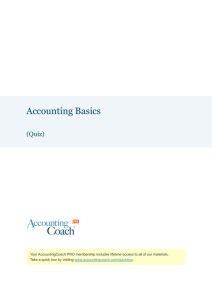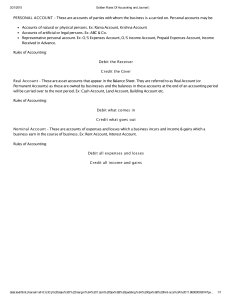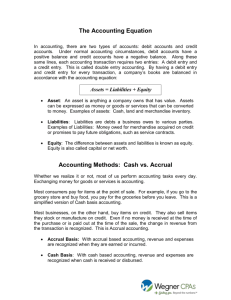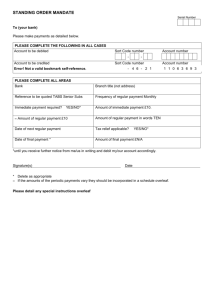credits
advertisement
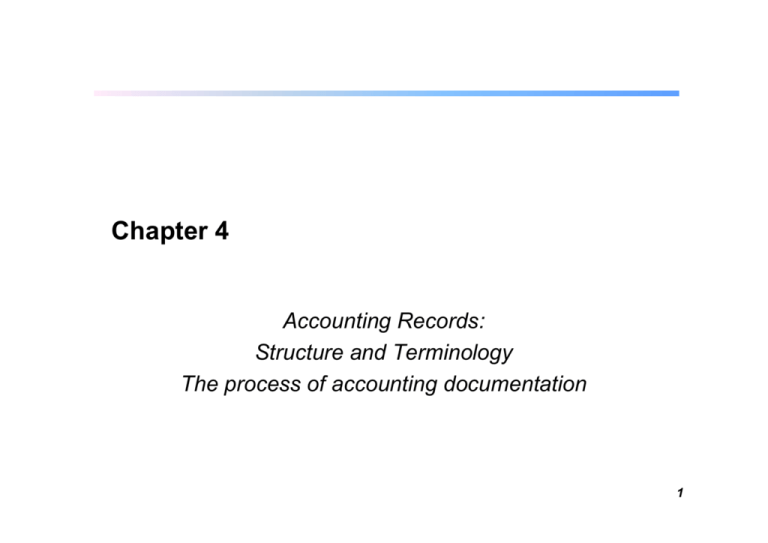
Chapter 4 Accounting Records: Structure and Terminology The process of accounting documentation 1 Basic Element of Double Entry Bookkeeping z The T account records the effect of transactions under one accounting aspect two opposite effects possible, e.g. inflows opposite to outflows inflows are summed on one side, outflows on the other z Example: The cash account Beginning balance b Outflows Inflows y1 ... ... yt x1 xt 2 Axioms z 1. 2. The left hand side of any T-account is called the debit side, the right hand side is called the credit side. Every transaction must be recorded with (at least) one debit and one credit entry, in such a way that total debit entries due to the transaction equal total credit entries due to the same transaction in the accounts. Initial balance and cash inflows are debited (= booked on the debit side), cash outflows are credited... e.g. if an amount of money is received from a credit the counter item is an addition to the right hand side of the account for the creditor 3 Closing an account is a transaction 1. 2. 3. 4. Sum the entries on the larger side below the line repeat the sum below the line on the other side strike the balance: insert the amount missing such that the sums of entries on both sides are equal (i.e. solving the account equation) enter the counter item to the appropriate account Cash (Period 1) Beginning balance 100 Outflows 400 Inflows 400 3. Balance 600 200 300 1. 1000 Cash (Period 2) 4. Beginning balance 600 2. 1000 4 Booking of the counter item (in theory) z appropriate account need not be the cash account of the next period could be a hierarchically superior closing account, e.g. “cash and cash equivalents” this could be closed to the balance sheet in order to reopen accounts for the next period the line item cash and cash equivalents in the balance sheet could be counterbooked to an account which is closed by booking out the individual items to the respective accounts, e.g. the cash account for the next period z This is not the practical procedure, this theoretically possible procedure shall only make clear the mechanics of double entry bookkeeping 5 Meaning of debit and credit z The choice of the right account side is the core of the art of bookkeeping so accountants since the middle ages looked for a theory to determine that one possible „theory“ is the personalistic theory: it considers each account as representing a partner of the business owner: e.g. the owner gives the cash to the cashier. So the cashier owes (Latin: debet) to the owner the amount of money in cash. the counter item is a credit item, e.g. on the creditor‘s account. The creditor has entrusted (Latin: credet) us the money. The english words are shortcuts debit for debitor („dr.“) and credit for creditor (cr.) 6 z z debiting an account Æ make an entry on the lefthand side of an account crediting an account Æ make an entry on the righthand side of an account total of debit amounts > total of credit amounts debit balance total of debit amounts < total of credit amounts credit balance z note that a debit balance occurs on the credit side on account closing and vice versa. normal balance ≡ side (debit or credit) that increases the stock or flow represented in the account 7 Derived rules Recall the basic accounting equation Assets = Liabilities + Owner‘s Equity Ö if a debit increases assets, then a credit counter item has to increase liabilities (or owner‘s equity) Ö i.e. increases and decreases in assets and liabilities (or owner‘s equity) must be recorded opposite to each other! z z Increases in assets are debited. Decreases in assets are credited. Increases in liabilities are credited. Decreases in liabilities are debited. Assets Debit for Increase Credit for Decrease Liabilities Debit for Decrease Credit for Increase 8 Owner‘s Equity z Recall that owner‘s investments and revenues increased owner‘s equity, while owner‘s withdrawals and expenses decreased owner‘s equity. z Separate accounts are kept for these items. z Owner‘s Capital. This account is affected by, for example, owner‘s investment. z Increases in owner‘s capital are credited. Decreases in owner‘s capital are debited. Owner's Capital Debit for Decrease Credit for Increase 9 Owner‘s Withdrawals z The owner may, for example, withdraw cash for personal use. It could be debited directly to Owner‘s Capital but a separate account is kept to determine total withdrawals. z Increases in owner‘s withdrawals are debited. Decreases in owner‘s withdrawals are credited. Owner's Withdrawal Debit for Increase Credit for Decrease 10 Revenues and Expenses z Revenues increase owner‘s equity, just as an increase in owner‘s capital does. Thus, debiting and crediting of a revenue account is the same as debiting and crediting of owner‘s capital account. Expenses, however, have the opposite effect. Revenues Debit for Decrease z z Credit for Increase Expenses Debit for Increase Credit for Decrease Increases in revenues are credited. Decreases in revenues are debited. Increases in expenses are debited. Decreases in expenses are credited. 11 The Expanded Basic Accounting Equation Expanded Basic Accounting Equation Assets = Liabilities + Assets = Liabilities + Increases Decreases (Dr.) (Cr.) Decreases Increases (Dr.) (Cr.) Assets + Expenses „uses“ (debits) Owner's Equity Owner's Capital - Owner's Withdrawal + Revenues Decreases Increases Increases Decreases Decreases Increases (Dr.) = (Cr.) (Dr.) (Cr.) (Dr.) (Cr.) - Expenses Increases Decreases (Dr.) (Cr.) Liabilities + Owner‘s Capital + Revenues „sources“ (credits) Note: Owner‘s withdrawal would appear on the lhs of the equation (it‘s also a debit) but was set zero to link together the five „elements“ of financial statements. 12 Example (1) (2) (3) (4) (5) (6) (7) (8) (9) A small company named ZiscoSys. The transactions are stated in chronological order: € 8.000 Owner‘s Investment to start up the business Purchase of equipment for € 4.000 paid in cash Purchase of supplies on credit for € 500 € 400 payment of a liability (accounts payable resulting from delivery of supplies) € 5.000 revenues earned on credit € 3.000 collection of accounts receivable Incurring expenses of € 500 for rent and € 200 for utility, resp., and Prepaid Insurance of € 1.200 reception of a down payment of € 2.400 for services to be performed (unearned revenue or deferred revenue), and Owner‘s withdrawal of € 800. 13 Transaction 1 – initial investment Cash Owner's Equity 8.000 8.000 Increase in cash is debited; increase in owner‘s equity is credited. Transaction 2 – purchase of equipment Cash Equipment 4.000 4.000 Decrease in cash is credited; increase in equipment is credited. 14 Transaction 5 – services rendered on credit Accounts Receivable Revenues 5.000 5.000 Increase in accounts receivable is debited; increase in revenues is credited. Transaction 7 – insurance policy bought Prepaid Insurance 1.200 Cash 1.200 Increase in prepaid insurance is debited; decrease in cash is credited. 15 Asset Accounts Cash 8.000 3.000 2.400 Accounts Receivable 4.000 400 500 1.200 800 6.500 5.000 3.000 2.000 Equipment Supplies Prepaid Insurance 4.000 500 1.200 4.000 500 1.200 = Owner's Equity Accounts Liability Accounts Accounts Payable 400 Unearned Revenue 500 200 2.400 300 2.400 + Owner's Investment Owner's Withdrawal 8.000 800 8.000 800 Revenues Expenses 5.000 500 200 5.000 700 16 Commonly Used Accounts z Different enterprises may use different accounts ⇒ the number and type (and name) depends on the nature of business and the size of the enterprise Caretaker service 9 sole proprietorship 9 one account for wage expenses ... rather low number of accounts 9 (probably) no account for plant and property Automobile manufacturer 9 corporate giant ... numerous accounts 9 separate accounts for wage expenses of, say, production and clerical workers 9 certainly (at least) one account for plant and property 17 Some important accounts common to most enterprises Chart of Accounts for a Small Business Assets Cash Notes Receivable Accounts Receivable Fees Receivable Office Supplies Prepaid Rent Prepaid Insurance Land Building Equipment z Liabilities 111 112 113 114 115 116 117 141 142 148 Notes Payable Accounts Payable Wages Payable Unearned Revenues Revenues 211 212 213 231 Owner's Equity Capital Withdrawal Income Summary 311 312 313 Sales Commissions Earned 411 412 Expenses Wages Expense Utility Expense Telephone Expense Insurance Expense Depreciation Expense, Equipment Depreciation Expense, Building 511 512 513 514 521 522 For tractability reasons, accounts are numbered! 18 The Recording Process Step 1: Journalizing z The journal is a complete and chronological list of all transactions that occurred. journal is the book of original entry! z common to have more than one kind of journal special purpose journals, e.g. cash receipts journal or sales journal z general journal: all transactions are recorded in this journal z a complete entry provides the following information date of recording date of transaction accounts and amounts to be debited and credited short explanation of the transaction number of account (if posted) 19 ZiscoSys‘ general journal General Journal Date 2003 Sept. Page 1 Post. Ref. Description 1 3 8 Debit Cash Owner's Investment Personal funds transferred to the account of ZiscoSys 8.000 Equipment Cash Equipment bought with cash payment 4.000 8.000 Simple entry 4.000 Compound entry Supplies Cash Accounts Payable Purchase of supplies partially with cash and on credit Simple entry ⇒ one debit and credit entry Credit 500 400 100 Compound entry ⇒ more than one debit and/or credit entry 20 Journal: the basic accounting document z The journal contains the complete information on transactions that enter the accounting system it is the basic documentation and serves as instrument of evidence in litigation it is not allowed to cancel journal entries • mistaken entries have to be reversed by a contra-entry z In electronic accounting systems the journal is the only data base on transactions the system has to assure that once an entry is made, it can no longer be influenced or altered by anyone ledger accounts are „views“ of the data base that are generated online, they are not records in their own right (Principle of data integrity: any information is only stored once) • the system of ledger accounts can thus be altered at any time according to new needs for analysis A sufficient number of safety copies (mirror images) of the journal have to be kept up-to-date. 21 Step 2: Posting z z z z all accounts taken together in one file ⇒ the ledger process of transferring journal entries to the ledger accounts ⇒ posting as with journals, there may be more than one kind of ledger general ledger contains all accounts general ledger asset accounts cash liability accounts notes payable accounts receivable prepaid expenses equipment accounts payable unearned revenues bonds owner‘s equity accounts owner‘s capital owner‘s withdrawal expenses revenues 22 Posting – ZiscoSys Magdeburg General Journal Date 2003 Sept. Page 2 Post. Ref. Description 3 Equipment Cash Equipment bought with cash payment 148 111 Debit Credit 4.000 4.000 General Ledger Equipment Date 2003 Sept. Item 2 3 Post. Ref. J1 J2 Debit Credit 1.000 4.000 Account No. 148 Balance Debit Credit 1.000 5.000 date page in journal account numbers General Ledger Cash Date 2003 Sept. Item 1 3 Post. Ref. J1 J2 Debit Credit 8.000 4.000 Account No. 111 Balance Debit Credit 8.000 4.000 23 Step 3: The Trial Balance z .... is a list of accounts and their balances at any equal point in time z usually prepared periodically (end of accounting period) z used to double-check equality of debits and credits z limitations: omission errors cannot be detected! possibly offsetting errors! z Input to preparation of financial statements (we‘ll see that later) 24 Trial Balance – ZiscoSys Magdeburg Trial Balance ZiscoSys Magdeburg Trial Balance September 30, 2003 Cash Accounts Receivable Equipment Supplies Prepaid Insurance Accounts Payable Unearned Revenue Owner's Investment Owner's Withdrawal Revenues Expenses 6.500 2.000 4.000 500 1.200 300 2.400 8.000 800 5.000 700 15.700 15.700 25 The Accounting Cycle Analyzing Enter Trans- Post from Prepare Ad- Prepare Source actions to Journal to justed Trial- Financial Documents the Journal Ledger Balance Statements 9 Coming up next 26 History of double-entry bookkeeping z oldest source: municipal records of Genoa, Italy, from 1340 z first systematic presentation: Luca Pacioli: „Summa de Arithmetica, Geometria, Proportioni et Proportionalita“ (Venice 1494) in medieval Latin. Luca Pacioli, 1445 – 1514 portrait by Jacopo Barbari 1495 Translations: • J.B. Geijsbeek, Ancient Double Entry Bookkeeping: Lucas Pacioli's Treatise, 1914 • Pacioli, Luca: Abhandlung über die Buchhaltung, 1494 (übers. von B. Penndorf) Stuttgart : Poeschel, 1968, Unveränd. Nachdr. d. Ausg. Stuttgart, Poeschel, 1933 27


